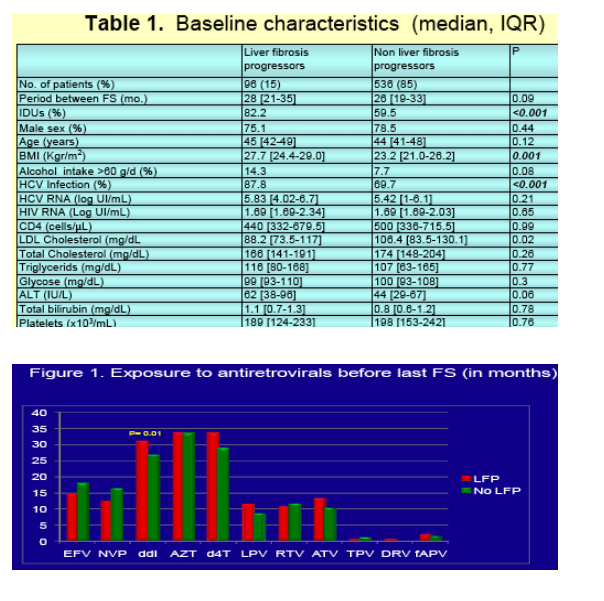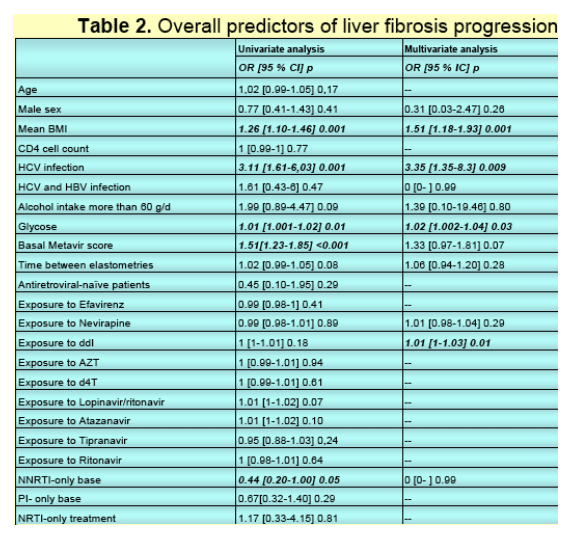 |
 |
 |
| |
Progression of Liver Fibrosis in a Large Cohort of HIV Patients Over 4 Years: Emerging Contribution of Antiretrovirals and Metabolic Abnormalities
|
| |
| |
Reported by Jules Levin CROI 2009 Feb 8-12
P Barreiro, Jose Vicente Fernandez-Montero*, P Labarga, M Vispo, F Blanco, P Tuma, J Medrano, V Rodriguez, J Gonzalez-Lahoz, and V Soriano
Hosp Carlos III, Madrid, Spain
Background: Liver disease is one of the most common causes of complications in HIV individuals. Contributors to liver fibrosis progression (LFP) have been mostly assessed in small, cross-sectional, retrospective studies. The recent availability of non-invasive tools to determine liver fibrosis stage has permitted to conduct prospective longitudinal studies in large numbers of patients.
Methods: A prospective cohort of HIV patients examined by elastometry (Fibroscan) was established at our institution in 2004. In subjects with 2 Fibroscan examinations separated by ≥18 months, factors associated with LFP were evaluated in 2008. LFP was defined as an increase from ≦9.2 kPa (F0 to F2 Metavir estimate) to >9.2 kPa (F3 to F4) between FS1 and FS2, or ≥30% increase in liver stiffness in patients with >9.2 kPa at FS1.
Results: We included in the study 632 HIV patients-median age 45 years; 78% males; 63% injection drug users [IDU]; median body mass index 23 kg/m2; median CD4 count 494 cells/μL; serum hepatitis C virus (HCV) RNA+ 72%; hepatitis B surface antigen (HBsAg)+ 10%; alcohol abuse 9%. Median time between Fibroscan examinations was 27 (19 to 33) months. Metavir estimates F3 to F4 were found in 190 (30%) patients at Fibroscan 1. Overall, 96 (15%) patients showed LFP at Fibroscan 2. ART between Fibroscan 1 and 2 with NNRTI (OR 0.44 [0.2 to 1.0]), but not with PI (OR 0.7 [0.3 to 1.4]) or triple NRTI (OR 1.2 [0.3 to 4.1]) regimens, was inversely associated with LFP. In a multivariate analysis (OR, 95%CI) factors associated with LFP were high body mass index (1.3, 1.1 to 1.6), serum HCV RNA+ (2.5, 1.1 to 6.0), alcohol abuse (6.27, 1.1 to 39), advanced Metavir stage at Fibroscan 1 (1.3, 1.0 to 1.8), elevated alanine aminotransferase (1.01, 1.01 to 1.02), high glycemia (4.7, 0..9 to 25.0), and total exposure to didanosine (1.01, 1.00 to 1.20).
Conclusions: Progression of liver fibrosis in HIV patients is associated with classical factors, as HCV co-infection or alcohol abuse, and may be less frequent in patients treated with NNRTI-based regimens. In addition, elements of the metabolic syndrome (high body mass index, hyperglycemia) may equally contribute to LFP in HIV patients.


|
| |
|
 |
 |
|
|